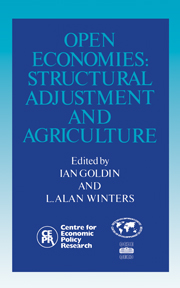Book contents
- Frontmatter
- Contents
- List of figures
- List of tables
- Preface
- Acknowledgements
- List of conference participants
- 1 Introduction: from macro to maize
- Part One Open economy analysis
- 2 Sequencing and welfare: labour markets and agriculture
- Discussion
- 3 Agricultural adjustment and the Mexico-USA free trade agreement
- Discussion
- 4 Do the benefits of fixed exchange rates outweigh their costs? The CFA Zone in Africa
- Discussion
- 5 Adjustment and the rural sector: a counterfactual analysis of Morocco
- Discussion
- Part Two The small country assumption and trade reform
- Part Three Risk and adjustment
- Part Four Government's role
- Index
Discussion
from Part One - Open economy analysis
Published online by Cambridge University Press: 04 August 2010
- Frontmatter
- Contents
- List of figures
- List of tables
- Preface
- Acknowledgements
- List of conference participants
- 1 Introduction: from macro to maize
- Part One Open economy analysis
- 2 Sequencing and welfare: labour markets and agriculture
- Discussion
- 3 Agricultural adjustment and the Mexico-USA free trade agreement
- Discussion
- 4 Do the benefits of fixed exchange rates outweigh their costs? The CFA Zone in Africa
- Discussion
- 5 Adjustment and the rural sector: a counterfactual analysis of Morocco
- Discussion
- Part Two The small country assumption and trade reform
- Part Three Risk and adjustment
- Part Four Government's role
- Index
Summary
Introduction
The overwhelming majority of developing countries pursue pegged arrangements, either to a single currency (the US dollar or the French franc) or to a currency basket (see Aghevli and Montiel, 1991). However, there is an increasing trend towards more flexible arrangements: during 1976–89, the proportion of countries relying on a managed float more than doubled to one-third of all developing countries.
The technique that Devarajan and Rodrik use in Chapter 4 is a costbenefit analysis analogous to that of Giavazzi and Giovannini (1987) (and of many other authors) who questioned what would be the costs and benefits of European countries joining the European Monetary System (EMS). The benefits of a fixed (but adjustable) exchange rate regime consist of lower inflation rates, and the costs potential output losses.
Devarajan and Rodrik compare the African member countries of the French franc Zone (FFZ) with their neighbours who pursue a flexible arrangement; they think that the comparison of these two exchange rate regimes ‘brings us as close to a controlled experiment as economists could hope for’. I am not at all in agreement with this statement. In Chapter 6 in this volume Ajay Chhibber compares the FFZ model with three alternative African exchange rates: fixed-but-adjusting exchange rates (as Zimbabwe, Malawi and Kenya), fixed-but-adjusting exchange rates with parallel markets (as Ghana, Nigeria, Tanzania and Zambia), and dual exchange rates (Algeria and Ethiopia). All three alternative systems practise heavy exchange controls while the CFA franc is fully convertible with respect to the French franc.
- Type
- Chapter
- Information
- Open EconomiesStructural Adjustment and Agriculture, pp. 86 - 92Publisher: Cambridge University PressPrint publication year: 1992



